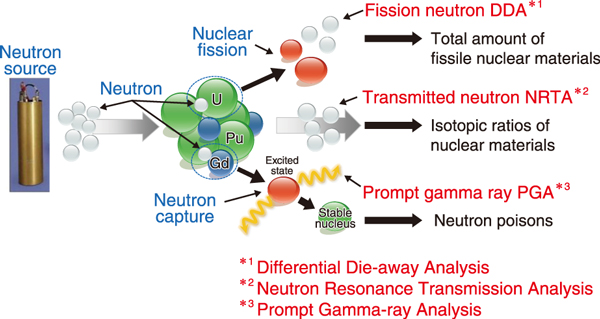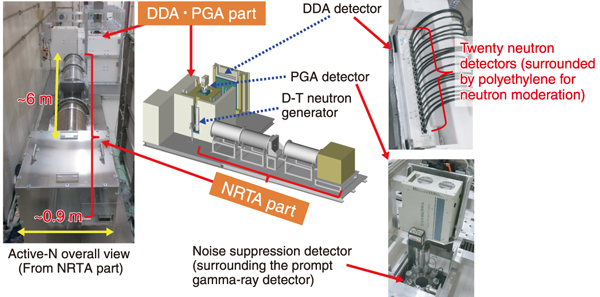
Fig.1 Measurement principles of three active nondestructive analysis (NDA) techniques

Fig.2 Schematic view and photos of the developed system, Active-N
When nuclear fuels used in nuclear power plants are reprocessed, it is necessary to measure the amount and isotopic ratios of nuclear materials (NMs) such as uranium (U) and plutonium (Pu). The spent fuel has a complex composition that is attributed to a variety of radioactive materials generated through nuclear fission, emitting significant radiation. A technique for nondestructive analysis (NDA) capable of measuring the amounts and isotopic ratios of NMs in these spent fuels has not been established as yet.
To overcome this issue, we developed the world’s first system, Active-N capable of performing measurements using three NDA techniques with a single DT neutron generator. The initial phase of the development was to explore NDA techniques that are applicable to NM measurements. We found that the complementary use of three active NDA techniques as shown in Fig.1 is effective. These techniques measure the neutrons and gamma (γ) rays induced by nuclear reactions between the neutrons externally irradiated on a sample and the NMs in the sample. Differential die-away analysis (DDA) can rapidly and accurately quantify the total fissile NM content by detecting fission neutrons. Neutron resonance transmission analysis (NRTA) determines the isotopic ratios of NMs by detecting the neutrons transmitted from a sample. However, when DDA and NRTA are performed for a sample that contains neutron poisons such as boron-10 and gadolinium (Gd), which absorb neutrons well, the amount of neutrons detected is reduced, resulting in the degradations of measurement accuracies. In this situation, prompt γ-ray analysis (PGA) can be used to measure the γ rays emitted when neutron poisons capture neutrons and determine the amounts and types of neutron poisons. Then the results are fed back to DDA and NRTA and thereby improve the measurement accuracies. The complementary roles of the three NDA techniques thus enable high-accuracy measurement of NMs in nuclear fuels such as spent nuclear fuels.
Initial investigations revealed that a mere combination of the three techniques causes mutual interference and leads to adverse effects and substantially reduces the measurement accuracies. In other words, to realize a system combining the three techniques, we must enhance the signal-to-noise ratios that directly affect the measurement accuracy while reducing mutual interference to the maximum extent possible. Hence, to reduce the interference in each measurement, we first conducted repeated simulations and detailed evaluations of the materials, shapes, weights, layouts, and detection efficiency of the system. We then determined the system specifications that avoid any adverse effects on individual measurements. Next, to enhance the signal-to-noise ratios, we developed a DDA detector system that suppresses γ-ray generation from neutron irradiation and is nearly insensitive to γ rays (~10-7), a PGA detector system that reduces the effect of fast neutrons by combining two detectors, and an NRTA detector system that is almost unaffected by γ rays because it discriminates between neutrons and γ rays (>99% removal). Fig.2 shows the developed system “Active-N.” Thus, by considerably enhancing the capabilities of individual techniques, we demonstrated the following: the DDA can rapidly measure the fissile NM content in simulated spent nuclear fuel; the PGA can measure neutron poisons in a short time; and the NRTA can determine the isotopic ratios of NMs.
The knowledge acquired from Active-N is expected to lead to future development of an NDA system in the field of nuclear security (material accountancy).
This research was implemented as part of the subsidy for “Nuclear security promotion project (FY2018-2021),” supported by MEXT.
(Harufumi Tsuchiya)
<Previous: 4 Nuclear Science and Engineering Research | Next: 4-2>